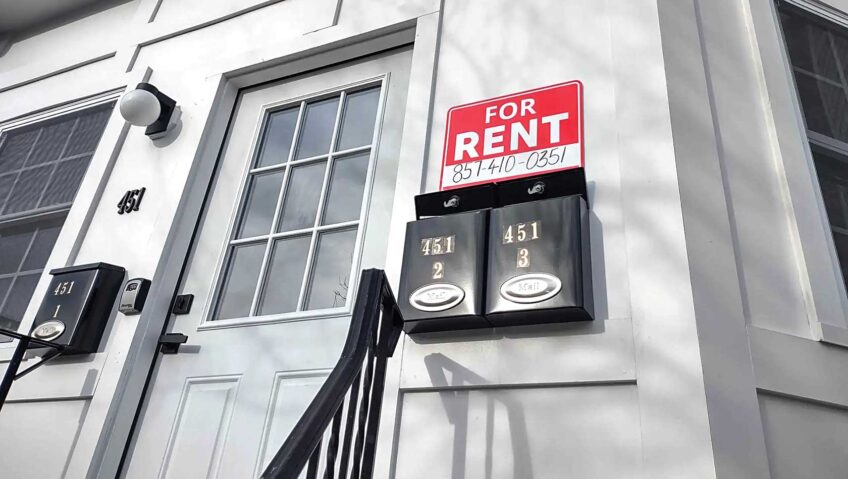Renovations to historic Lenox Apartments complete
1939 Roxbury public housing revamped

As heavy rains poured down in Boston last Thursday, a celebration for the concluded renovation of the historic Lenox Apartments in Lower Roxbury moved indoors. City officials, stakeholders and tenants gathered inside a newly refurbished community center to commemorate the completed redevelopment of the complex, built in 1939 as the first public housing development for Black residents in Boston.
“Home is where your basic needs are met. Home is where your dreams grow. And home is where people we love are,” said Mayor Michelle Wu. “And so, we want to create that around all of our city. And today is another huge step in connecting that history of homemaking through to the present and into our future.”
The 85-year-old development is made up of 12 multifamily residential buildings and a community center, all of which needed upgrades to address safety, sanitary, accessibility and quality of life issues, said Jaissa Feliz, development director at Beacon Communities, the real estate developer for the project.
During a comprehensive, two-and-a-half-year construction project, the developer installed new windows, insulation and in-unit washers and dryers in each apartment. The renovation also included upgrades to the security system, landscaping and outdoor play areas, as well as improvements to the community center featuring new and revamped amenities.
Feliz said the redevelopment, which totaled $120 million, is a welcome investment into the community.
“The value is preserving 285 apartments as affordable housing for low-income residents in a rapidly gentrifying area that is experiencing high housing costs that continue to rise,” she said in an interview.
Also preserved recently was the historical significance of the property, cemented when Lenox Apartments Historic District was entered into the National Register of Historic Places.
Approximately 20 years before the Lenox Apartments were first built, Lower Roxbury was transitioning from a white, working-class neighborhood to a Black one, said Byron Rushing, historian and former state representative.
Public housing was a product of the Great Depression as the government experimented with ways to create opportunities for disadvantaged communities. Rushing told the audience at the April 4 ribbon-cutting that the history embedded within Lenox Apartments ought not to be overlooked.
“You cannot talk about Lenox without talking about Black people. You cannot talk about Lenox without talking about the struggles of Black people. You cannot talk about Lenox without talking about segregation in Boston,” he said.
During their remarks, speakers from the Boston Housing Authority, which owns the land Lenox Apartments was built on, highlighted the lack of funding public housing projects receive, despite the need. The Lenox Apartments redevelopment was funded through low-income housing tax credits, equity from the sale of historic tax credits and a loan from MassHousing.
Boston Housing Authority administrator Kenzie Bok touted Lenox Apartments as an example of the necessity for public affordable housing.
“Public housing was for a long time talked about in this country like an idea of the past, like a set of dinosaur institutions that were passing away,” she said. “And yet … we are finding the exact same thing that our predecessors did 80 years ago, which is that if you want to anchor people from all walks of life in the city, you have to have a public role in the creation of housing.”
The history and present of Lenox Apartments are celebrated in artworks hanging in the community center. Artists Rob “ProBlak” Gibbs and Damon Butler, both of whom grew up at Lenox Apartments, worked together to create the two pieces that adorn the building.
One of the pieces, hanging in the common area, is a painting of a Black child clad in a tracksuit and sneakers, squatting in front of a boom box. The other, located in the hallway, is composed of two panels, each depicting a grayscale forearm, one with a tattoo sprawling across it. The ink art reads, in all caps, “Respect.”
Both Gibbs and Butler witnessed Lower Roxbury evolve in the 1980s and 1990s. Butler remembered his time at Lenox Apartments fondly, noting that, “I wasn’t rich, but I had a wealth in community and in culture.” He called the transformation of the complex “awe-inspiring.”
Ruby M. Dilligard, a Lenox Apartments resident of almost 30 years, said she is pleased with the new renovation, especially the in-unit washer and dryer.
“It’s almost like a miracle,” said the 81-year-old. “I don’t have to go to the laundromat anymore. Everything is right there at your fingertips.”
The updated space is an improvement from the previous one, which she said was “dreary” and “nothing to brag about.” Dilligard said she exercises at the new community center once a week and gets massages there once a month. For her, the newly renovated property symbolizes “a new day.”






